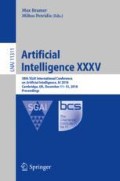Abstract
Rule based systems are an important class of computer languages. The brain, and more recently neuromorphic systems, is based on neurons. This paper describes a mechanism that converts a rule based system, specified by a user, to spiking neurons. The system can then be run in simulated neurons, producing the same output. The conversion is done making use of binary cell assemblies, and finite state automata. The binary cell assemblies, eventually implemented in neurons, implement the states. The rules are converted to a dictionary of facts, and simple finite state automata. This is then cached out to neurons. The neurons can be simulated on standard simulators, like NEST, or on neuromorphic hardware. Parallelism is a benefit of neural system, and rule based systems can take advantage of this parallelism. It is hoped that this work will support further exploration of parallel neural and rule based systems, and support further work in cognitive modelling and cognitive architecture.
Access this chapter
Tax calculation will be finalised at checkout
Purchases are for personal use only
References
Altmann, G., Trafton, J.: Memory for goals: an activation-based model. Cogn. Sci. 25(1), 39–83 (2002)
Anderson, J., Lebiere, C.: The Atomic Components of Thought. Lawrence Erlbaum, Mahwah (1998)
Brette, R., Gerstner, W.: Adaptive exponential integrate-and-fire model as an effective description of neuronal activity. J. Neurophysiol. 94, 3637–3642 (2005)
Byrne, E., Huyck, C.: Processing with cell assemblies. Neurocomputing 74, 76–83 (2010)
Davison, A., et al.: PyNN: a common interface for neuronal network simulators. Front. Neuroinformatics 2, 11 (2008)
Fan, Y., Huyck, C.: Implementation of finite state automata using flif neurons. In: IEEE Systems, Man and Cybernetics Society, pp. 74–78 (2008)
Forgy, C.: Rete: a fast algorithm for the many pattern/many object pattern match problem. In: Readings in Artificial Intelligence and Databases, pp. 547–559 (1988)
Furber, S., et al.: Overview of the spinnaker system architecture. IEEE Trans. Comput. 62(12), 2454–2467 (2013)
Gewaltig, M., Diesmann, M.: NEST (neural simulation tool). Scholarpedia 2(4), 1430 (2007)
Hebb, D.O.: The Organization of Behavior: A Neuropsychological Theory. Wiley, New York (1949)
Hodgkin, A., Huxley, A.: A quantitative description of membrane current and its application to conduction and excitation in nerve. J. Physiol. 117, 500–544 (1952)
Kieras, D., Wood, S., Meyer, D.: Predictive engineering models based on the epic architecture for a multimodal high-performance human-computer interaction task. ACM Trans. Comput. Hum. Interact. 4(3), 230–275 (1997)
Laird, J., Newell, A., Rosenbloom, P.: Soar: an architecture for general cognition. Artif. Intell. 33(1), 1–64 (1987)
Lewis, H., Papadimitriou, C.: Elements of the Theory of Computation. Prentice-Hall, Inc., Englewood Cliffs (1981)
McCulloch, W., Pitts, W.: A logical calculus of ideas immanent in nervous activity. Bull. Math. Biophys. 5, 115–133 (1943)
Newell, A., Simon, H.: The logic theory machine-a complex information processing system. IRE Trans. Inf. Theory 2(3), 61–79 (1956)
Post, E.: Formal reductions of the general combinatorial decision problem. Am. J. Math. 65(2), 197–215 (1943)
Riley, G., Culbert, C., Lopez, F.: C language integrated production system. Technical report, NASA (1989)
Acknowledgments
This work has received funding from the European Union’s Horizon 2020 research and innovation programme under grant agreement No. 720270 (the Human Brain Project).
Author information
Authors and Affiliations
Corresponding author
Editor information
Editors and Affiliations
Rights and permissions
Copyright information
© 2018 Springer Nature Switzerland AG
About this paper
Cite this paper
Huyck, C., Kreivenas, D. (2018). Implementing Rules with Artificial Neurons. In: Bramer, M., Petridis, M. (eds) Artificial Intelligence XXXV. SGAI 2018. Lecture Notes in Computer Science(), vol 11311. Springer, Cham. https://doi.org/10.1007/978-3-030-04191-5_2
Download citation
DOI: https://doi.org/10.1007/978-3-030-04191-5_2
Published:
Publisher Name: Springer, Cham
Print ISBN: 978-3-030-04190-8
Online ISBN: 978-3-030-04191-5
eBook Packages: Computer ScienceComputer Science (R0)

